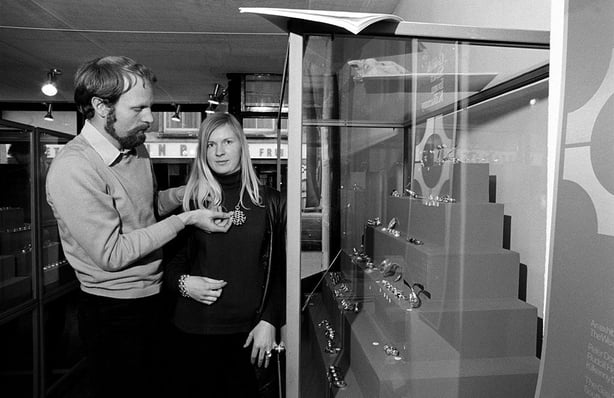German jewellery maker Rudolf Heltzel has made Kilkenny his home.
Rudolf Heltzel has been working at the Kilkenny Design Centre for the last seven years. The German had been invited to come and work there. He now has his own studio where working with him are Martin Mahony and Michael Fitzpatrick.
Rudolf Heltzel describes the process behind his work. The initial design idea is put down on paper before choosing the raw materials, and deciding on dimensions before the intricate craftwork begins. In this case, he demonstrates how a silver pendant is crafted. Cutting, assembling, soldering, firing, and polishing. The final stage involves the maker embossing his initials on the piece.
These are in a way my own guarantee that the piece is up to the standard I want the piece to have.
Much of the silver and gold jewellery made the workshop is sold overseas and in the Kilkenny Craft Centre run by his wife Eva. The centre is located at Rothe House, a 16th-century merchant's dwelling which was renovated by the Board of Works in Kilkenny. The building is now home to an archaeological museum, a butcher shop, and a craft shop.

Photo by Roy Bedell.
Starting out, Rudolf Heltzel worked more with silver than gold as it is a cheaper material. For financial reasons, he mainly makes jewellery which is in demand. While working as a goldsmith and silversmith for many years, he says you never stop learning. The apprenticeship itself lasts for four years and while he receives a lot of applications for positions as apprentices, not everyone is suitable. He says that there is a vocational element to the occupation that not everyone has.
Rudolf Heltzel refutes the claim that the Irish are visually illiterate. He acknowledges that young people in school lack visual training and education and that many Irish homes show no interest in the visual aspects of life. As a result,
You can't really expect anybody to have high visual standards.
He believes Ireland's geographic isolation is a major factor at play in the lack of appreciation for visual design. He does see this changing in Ireland with improvements being made. As the country becomes wealthier, people become more discriminatory about what they buy.
Improvement comes about once people start to earn money. If you have money, you can spend money.
For Rudolf Heltzel, Ireland has had an obsession with Celtic art and believes that the country needs to look to the future and evolve.
This episode of 'Tangents' was broadcast on 8 January 1974. The presenter is Doireann Ní Bhriain.

























